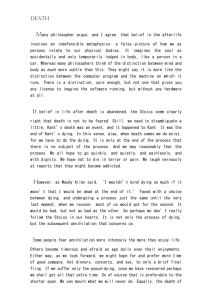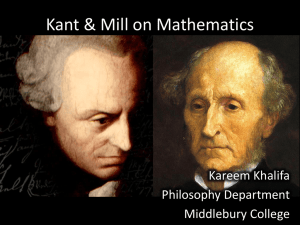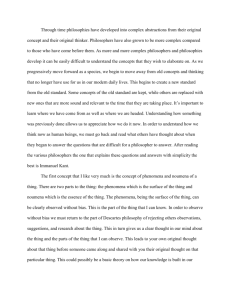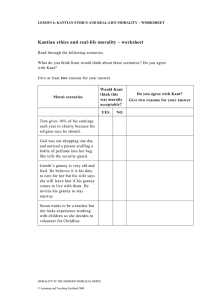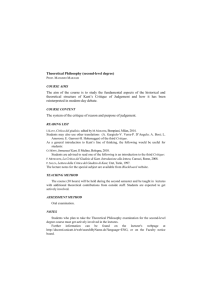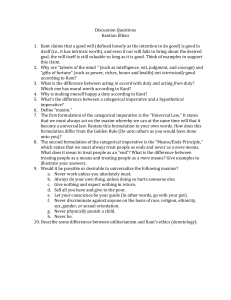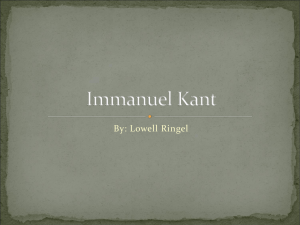24.201 Topics in History of Philosophy: KANT Phenomena and Noumena Kant’s distinction.
advertisement
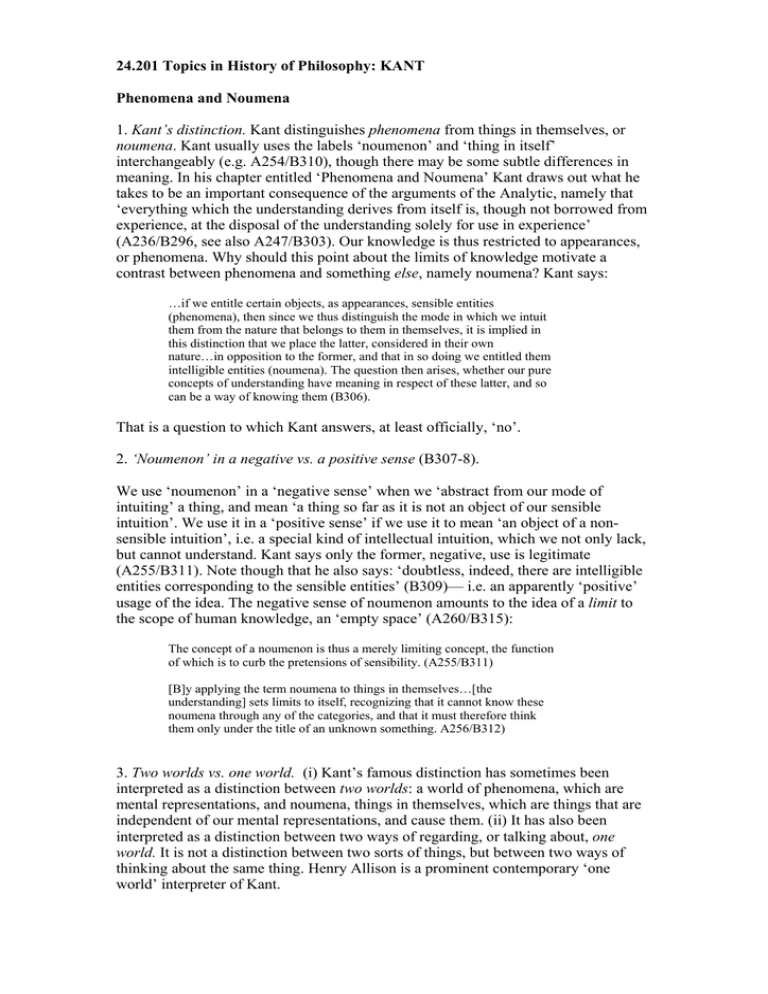
24.201 Topics in History of Philosophy: KANT Phenomena and Noumena 1. Kant’s distinction. Kant distinguishes phenomena from things in themselves, or noumena. Kant usually uses the labels ‘noumenon’ and ‘thing in itself’ interchangeably (e.g. A254/B310), though there may be some subtle differences in meaning. In his chapter entitled ‘Phenomena and Noumena’ Kant draws out what he takes to be an important consequence of the arguments of the Analytic, namely that ‘everything which the understanding derives from itself is, though not borrowed from experience, at the disposal of the understanding solely for use in experience’ (A236/B296, see also A247/B303). Our knowledge is thus restricted to appearances, or phenomena. Why should this point about the limits of knowledge motivate a contrast between phenomena and something else, namely noumena? Kant says: …if we entitle certain objects, as appearances, sensible entities (phenomena), then since we thus distinguish the mode in which we intuit them from the nature that belongs to them in themselves, it is implied in this distinction that we place the latter, considered in their own nature…in opposition to the former, and that in so doing we entitled them intelligible entities (noumena). The question then arises, whether our pure concepts of understanding have meaning in respect of these latter, and so can be a way of knowing them (B306). That is a question to which Kant answers, at least officially, ‘no’. 2. ‘Noumenon’ in a negative vs. a positive sense (B307-8). We use ‘noumenon’ in a ‘negative sense’ when we ‘abstract from our mode of intuiting’ a thing, and mean ‘a thing so far as it is not an object of our sensible intuition’. We use it in a ‘positive sense’ if we use it to mean ‘an object of a nonsensible intuition’, i.e. a special kind of intellectual intuition, which we not only lack, but cannot understand. Kant says only the former, negative, use is legitimate (A255/B311). Note though that he also says: ‘doubtless, indeed, there are intelligible entities corresponding to the sensible entities’ (B309)— i.e. an apparently ‘positive’ usage of the idea. The negative sense of noumenon amounts to the idea of a limit to the scope of human knowledge, an ‘empty space’ (A260/B315): The concept of a noumenon is thus a merely limiting concept, the function of which is to curb the pretensions of sensibility. (A255/B311) [B]y applying the term noumena to things in themselves…[the understanding] sets limits to itself, recognizing that it cannot know these noumena through any of the categories, and that it must therefore think them only under the title of an unknown something. A256/B312) 3. Two worlds vs. one world. (i) Kant’s famous distinction has sometimes been interpreted as a distinction between two worlds: a world of phenomena, which are mental representations, and noumena, things in themselves, which are things that are independent of our mental representations, and cause them. (ii) It has also been interpreted as a distinction between two ways of regarding, or talking about, one world. It is not a distinction between two sorts of things, but between two ways of thinking about the same thing. Henry Allison is a prominent contemporary ‘one world’ interpreter of Kant. 4. An old problem for Kant’s distinction There is a famous problem for Kant’s distinction between phenomena and things in themselves, when it is understood the ‘two worlds’ way. We will look at the problem now, and then look at two different ways one could solve it. Here is the problem. K1 Things in themselves exist. K2 Things in themselves are the causes of phenomenal appearances. K3 We can have no knowledge of things in themselves. The epistemological thesis (K3) appears to imply these corollaries: C1 We cannot know that things in themselves exist. C2 We cannot know that things in themselves are the causes of phenomenal appearances. We cannot know K1 and K2. Kant’s story makes itself untellable. 5. Allison’s deflationary proposal Allison’s ‘one world’ interpretation seems to make the problem go away. Here is what K1-K3 look like on his interpretation. A1 We can consider things “in themselves”, i.e. in abstraction from the conditions of our sensibility. A2 Things considered in abstraction from the conditions of our sensibility can be considered only as something that affects the mind. A3 Things considered in abstraction from their relation to our sensibility are things considered in abstraction from their relation to our sensibility. Objection: Allison makes it trivially analytic that we are ignorant of things in themselves, or noumena. But Kant thinks we are missing out on something in not knowing things as they are in themselves. Kant speaks of our yearning for something more; he speaks of doomed aspirations, he speaks of “our inextinguishable desire to find firm footing somewhere beyond the bounds of experience” (A796/B824). It is not easy to see to see how this inextinguishable desire could be for the falsity of A3. 6. An alternative proposal In Kantian Humility, I argue for a different solution to the problem. There is one world, one set of things, but two kinds of properties: intrinsic properties, and properties “in opposition” to the intrinsic, namely relational properties (B306-7). The labels “phenomena” and “noumena” seem to label different entities, but really they label different classes of properties of the same set of entities. A distinction between two sets of properties is a metaphysical distinction, with epistemological significance. To have knowledge of a thing in itself, Kant says, would be to be able to ascribe to it distinctive intrinsic predicates (A565/B593), which we cannot do. K1-K3 should be understood something like this: L1 There exist things in themselves, i.e. things that have intrinsic properties. L2 The things that have intrinsic properties also have relational properties, in particular, causal powers that constitute phenomenal appearances. L3 We have no knowledge of the intrinsic properties of things. Instead of an inconsistent triad, we have a consistent one. Kant’s existence claim in K1 looked incompatible with the knowledge claim of K3: if we literally have no knowledge of things in themselves, then we do not even know that they exist. If K3 is true, then K1 is false. But interpreted as L3 and L1 there is no inconsistency. We can know that there are things that have intrinsic properties without knowing what those properties are. Knowledge of things as they are in themselves involves the ability to ascribe “distinctive intrinsic predicates” to a thing. That involves more than simply knowing that there are things that have intrinsic properties. Kant’s causal claim in K2 looked incompatible with the knowledge claim of K3. The claim that things in themselves affect us, and that things in themselves are the cause of phenomena, conflicts with the claim that we have no knowledge of things as they are in themselves. If K3 is true, then K2 is false. Interpreted as L3 and L2, however, there is no inconsistency, at least on a certain assumption. On the assumption that causal powers are not intrinsic properties, we can know that a thing has certain causal powers without knowing what its intrinsic properties are. The old and ugly problem for Kant’s distinction disappears. The third claim about knowledge does not undermine the first two. It has no unwelcome corollaries. Kant’s story about phenomena and noumena does not make itself untellable. For more on this topic, read Langton, Kantian Humility, chapter 1.
